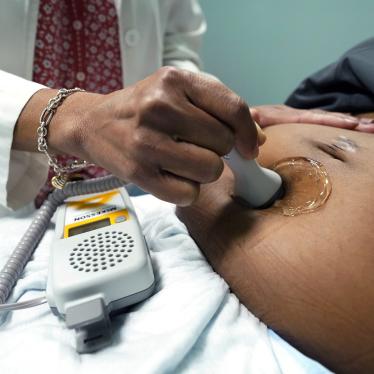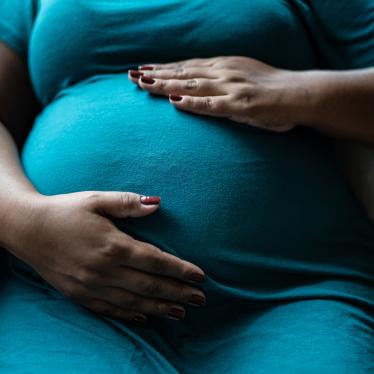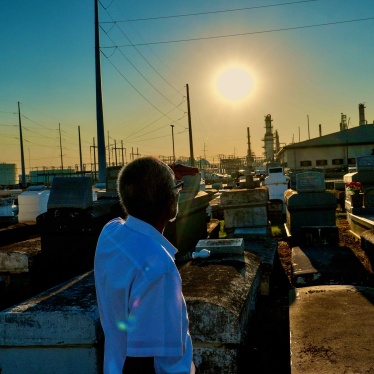Submission by Human Rights Watch to the UN Special Rapporteur on Toxics, Marcos Orellana regarding toxics and gender
Human Rights Watch welcomes the opportunity to provide input ahead of the Special Rapporteur’s upcoming report on gender and toxics.
This submission is to provide information about some research by Human Rights Watch concerning the intersection of gender and toxics. We hope that this submission will provide useful examples of how toxics create additional harms to certain people because of their sex or gender and how government failures to acknowledge and act on these concerns often undermine the right to health, the right to a healthy environment and associated human rights.
We also wish to communicate a few general points that we consider to be important as the contents of your report is decided:
- Human Rights Watch recommends that your report use multiple, intersectional lenses together with gender to more accurately describe how women, girls, minority genders, and at times men and boys may be especially at risk because of their gender. Like many others, our reporting (see below) has found women and girls are often at risk from environmental toxics because of their biology and that work and other aspects of their lives have been gendered. The dangers are increased when they are poor or from minority-language, immigrant, Indigenous, ethnic, or racial populations.
- Human Rights Watch recommends that the extreme vulnerability of pregnant women and other pregnant people to toxics including from fossil fuels, mining, and management of plastics be of special concern, given the large number of studies showing evidence about the precarity of pregnant people. At the same time, a growing body of research is making the many sexual and reproductive health harms from toxics clearer.
- Recently published and ongoing research by Human Rights Watch (see below) has highlighted ways the fossil fuel industry creates reproductive toxics and other gendered harms to human physical and mental health and well-being more broadly. We recommend a significant focus in your report on fossil fuel-related harms that contribute to the necessity of rapidly phasing out fossil fuels. Our extensive work on mining and health harms shows the importance of your highlighting the damage to reproductive health and women’s rights caused by the abusive practices of companies and governments in the extraction and production of mineral and other product, including those used in the energy transition.
- In general, we are distressed in places where we have done research by the lack of action from governments to better protect people from environmental harms to their health. We urge you to encourage international bodies, including the UN system’s service-providing agencies, to work with governments to do more to identify and tackle toxic harms to human health and well-being, notably harms to sexual and reproductive health.
- Information, analysis, and advocacy on the importance of maintaining planetary health and healthy local environments for human health have been a strong contribution from some in the women’s rights and the sexual and reproductive rights movements, particularly from organizations embedded within Indigenous or feminist movements in low- and middle-income countries. However, the “mainstream” or best-resourced women’s rights movements, and sexual and reproductive health movements, as well as government systems and international systems that provide and advocate for sexual and reproductive health, have largely ignored the dimension of environmental health and relevant rights. This longstanding omission should be acknowledged, and changes urgently made.
Canada: “Make it Safe: Canada’s Obligations to End the First Nations Water Crisis”
Canada, one of the wealthiest countries in the world, is also one of the most water-rich. Access to sufficient, affordable, and safe drinking water and adequate sanitation is easy for most Canadians. But this is not true for many First Nations Indigenous persons. In stark contrast, the water supplied to many First National communities on lands known as reserves is contaminated, hard to access, or at risk due to faulty treatment systems. The government regulates water quality for off-reserve communities but has no binding regulations for water on First Nations reserves. The right to water entitles people to water that is culturally acceptable, and the United Nations Declaration on the Rights of Indigenous Peoples (UNDRIP) recognizes Indigenous peoples’ right to maintain and strengthen their spiritual relationship with traditionally owned or occupied lands, territories, waters, coastal seas, and other resources and to uphold their responsibilities to future generations in this regard. However, in practice, First Nations persons cannot engage fully in their relationship with water when it is contaminated.
Many elders described water as living, and that all of the components of water are important to the health of a person. Not being able to drink the water from their own community is distressing to some. Poor water quality may have a negative impact on ceremonies when source water used in the ceremonies cannot be consumed directly. It can also have an impact on traditional practices, including hunting and fishing. Pollutants can make fish harmful to eat, and if water from springs, streams, and lakes is not safe for drinking throughout traditional territories, hunters and trappers cannot stay out on the land for long periods without returning to communities for water provisions.
Water is also fundamental to the continuance of cultural knowledge for many First Nations peoples. As one scholar notes, “Our relationship to water also plays a vital role in passing on knowledge to younger generations.” Some of these cultural harms are especially pertinent to women. In many First Nations communities, women are considered the keepers and spiritual protectors of waters. According to elders’ teachings and tradition, “Women are the water carriers and life givers,” and are “responsible to speak for water.” Carol N., an elder living in Batchewana First Nation, explained, “Water for us is sacred, spiritual.… Water is also a medicine.”
Contaminants in drinking water on First Nations reserves visited by Human Rights Watch included coliform, Escherichia coli (E. coli), cancer-causing Trihalomethanes (see here for impacts on birth weight), and uranium. Exposure to these types of contaminants can have health impacts that range from serious gastrointestinal disorders to increased risk of cancer. Studies also indicate pregnancy health concerns (see links). Caregivers—most often women—of children, elderly, and people with disabilities told Human Rights Watch that the poor water conditions in their communities made their care work more burdensome and time-consuming, and increased their worry about loved ones. Poor quality water can add hours to simple caregiving tasks.
As just one example of how contaminated water increased the burden of care on women from our report, a mother in Neskantaga First Nation described the hour-long daily process to wash bottles for her 4-month-old infant with a rare heart condition. She bathes him in water that she or her partner collects from the community’s reverse osmosis machine at the water treatment plant. It takes 10 minutes to walk to the treatment plant, and longer to walk back uphill with the water. Her partner often goes by bike, balancing water bottles on the handlebars as he rides. To bathe the baby, every two days she boils the water then lets it cool in a small tub. This takes about two hours. To wash her baby’s bottles, she first rinses the milk out with tap water. Then she boils water from the reverse osmosis machine with the bottles. She then washes them in the sink, again with the treated plant water. This takes an hour. “It makes me feel tired, exhausted. It’s stressful,” she said.
Ethiopia: Companies Long Ignored Gold Mine Pollution
At Lega Dembi gold mine in Ethiopia, people’s right to health including when pregnant has been violated for many years. Residents said there had been miscarriages, stillbirths, and congenital disabilities (disabilities at birth) affecting those who live adjacent to, or downstream from, the tailings ponds. Their accounts are supported by two unpublished studies that Human Rights Watch obtained, a 2018 compliance audit on chemical management and a study on community health initiated by the Ethiopian Public Health Institute and the Ministry of Mines and Petroleum in 2018. The compliance audit, conducted by Addis Ababa University, found high levels of arsenic in water samples taken downstream from the mine area, and high levels of nickel, chromium, and arsenic in soil samples outside the mine. The community health study found that children living in the area around the mine site had a significantly higher rate of congenital disabilities than those living in some other areas of Ethiopia; it also identified significantly increased rates of miscarriages and stillbirths. The study concluded that “communities living around Lega Dembi mining area were at risk of exposure to pollutants like toxic metals released from the mining plant and other mining activities.”
Human Rights Watch research on the Lega Dembi gold mine is also an example of how communities, including pregnant women, postpartum women, and parents of children living with disability, are unable to access appropriate government action, including non-repetition and other remedy for reproductive and other harms.
The company operating the Lega Dembi mine, Midroc Investment Group, and the Swiss refinery Argor-Heraeus that sourced gold from Lega Dembi until 2018, took no action to address the pollution. The Ethiopian government suspended the Lega Dembi industrial gold mine’s license in May 2018 following protests over pollution and its health impacts. The government said in a UN report that it would not permit the company to resume the mine’s operations until the issues were “resolved” and the toxic waste “no longer poses a threat.” However, Human Rights Watch research found that Midroc recommenced operations around March 2021 without any apparent steps taken to reduce pollution.
After publication of Human Rights Watch’s report, Midroc asserted that it had taken measures to reduce the pollution, in particular in relation to the tailings management. It did not provide information on measures to address the past pollution, nor did the government disclose any information on the measures taken. A 2021 Memorandum of Understanding between the government and Midroc with an action plan on efforts to address the problem has not been made public.
Turkey: “It’s As If They’re Poisoning Us” – The Health Impacts of Plastic Recycling in Turkey
Human Rights Watch documented the health impacts of plastic recycling on facility workers and residents living near facilities in Adana and Istanbul, Turkey in 2022. In 2020, Turkey was the single largest recipient of European Union plastic, importing nearly 450,000 tonnes.
Plastic products contain chemical additives that make them useful but which pose threats to human health and make it more difficult to recycle plastic products. Plastic producers are not required to disclose additives in their products, so consumers purchasing products with plastic packaging and workers handling plastic waste have no way of knowing if they are exposed to materials that could pose health threats.
Phthalates, bisphenol A (BPA), and per- and polyfluoroalkyl substances (PFAS) are common chemical additives in plastic that harm human health. Phthalates are a group of additives commonly found in polyvinyl chloride (PVC), which is used to make pipes, wire insulation, and window frames.
Plastic recycling in Turkey poses specific health harms to women and girls. Phthalates are endocrine disrupting chemicals that are linked to early menopause in women, low birth rates, and higher rates of miscarriage.
For women, girls, and pregnant people, toxic exposure can contribute to serious, lifelong health problems. Women generally have a higher proportion of body fat, making them more likely to store lipophilic, toxic chemicals in their tissues. Women and girls who are exposed to endocrine disrupting chemicals, including BPA, are at increased risk of polycystic ovarian syndrome and recurrent miscarriages. Environmental toxins in air, water, food, and cosmetics have been linked with female infertility. Exposure of girls and women to endocrine-disrupting chemicals prior to and during childbearing years can result in increased likelihood of children being born with disabilities, making this is a significant intergenerational issue. Exposure to air pollution for pregnant people can result in the translocation of pollutant nanoparticles in placental tissue. Endocrine-disrupting phthalates have been found to cross the placenta from blood and amniotic fluid, exposing the fetus to toxins that increase the likelihood of premature birth, children born with disabilities, and development of disabilities later in childhood.
US: “We’re Dying Here: The Fight for Life in a Louisiana Fossil Fuel Sacrifice Zone”
In the US state of Louisiana, in the area known as “Cancer Alley,” the fossil fuel and petrochemical industry has devastated the health, lives, and environment of residents. Cancer Alley refers to an approximately 85-mile stretch of communities along the banks of the Mississippi River between New Orleans and Baton Rouge, where communities exist side-by-side with some 200 fossil fuel and petrochemical operations. Residents face severe health harms including elevated burdens and risks of cancer, reproductive, maternal, and newborn health harms, and respiratory ailments. These harms are disproportionately borne by the area’s Black residents.
State and federal authorities have failed to properly regulate the industry, and they have not made information about risks to human health readily available. For decades the state of Louisiana, and the Louisiana Department of Environmental Quality in particular, has repeatedly failed to address the harms of fossil fuel and petrochemical operations to enforce the minimum stands set by the federal government and to protect the environment and human health. The US Environmental Protection Agency has not adequately ensured that federal laws and mandates and enforced in Louisiana and as such is failing to protect the air, land, water, and health of Louisiana residents from harms caused by the fossil fuel and petrochemical industry.
People interviewed by Human Rights Watch provided examples of reproductive health harms they associated with the fossil fuel and petrochemical operations in their neighborhoods, including stillbirths and miscarriages, infertility, and adverse birth outcomes such as low birthweight and preterm birth. Women also described the many ways that asthma and other diseases affecting their children increased their burden of care. Research presented for the first time in the Human Rights Watch report in Environmental Research: Health finds that people living in those areas with the worst air pollution in Louisiana, which includes many parts of Cancer Alley, had rates of low birthweight as high as 27 percent, more than double the state average (11.3 percent) and more than triple the US average (8.5 percent). Preterm births were as high as 25.3 percent, nearly double the state average (13 percent) and nearly two-and-a-half times the US average (10.5 percent). The leading source of industrial air pollution in Louisiana and Cancer Alley is the fossil fuel and petrochemical industry.
State and federal authorities should increase regulation and enforcement of the industry, deny permits in already overburdened communities, and support local calls for moratoriums on new or expanded fossil fuel and petrochemical operations while implementing a fossil fuel phase-out. Governments should ensure that providers and patients are provided with education and resources about the health risks associated with exposure to fossil fuels and petrochemicals including maternal, reproductive, and newborn health, cancer and respiratory ailments. Health services should be able to provide accessible and affordable health services to treat health harms associated with fossil fuels and petrochemicals.
Zambia: “We Have to be Worried” – The Impact of Lead Contamination on Children’s Rights in Kabwe, Zambia.
The town of Kabwe in Zambia is one of the worst pollution hot spots in Africa because of contamination from a former lead and zinc mine.[1] The mine, which was originally owned by British colonial companies, was closed in 1994, but its toxic waste was never cleaned up. As a result, lead dust from its large, uncovered waste dumps blows over to nearby residential areas, putting the health of 200,000 people at risk.
Pregnant and breastfeeding women and children under age 5 are among the most vulnerable to lead poisoning. Among pregnant women and girls, lead exposure can result in stillbirth, miscarriage, and low birthweight and can negatively affect the brain development of a fetus. The consequences for children include reading and learning barriers or disabilities; behavioral problems; impaired growth; anemia; brain, liver, kidney, nerve, and stomach damage; coma and convulsions; and death. Poor women and children are disproportionately affected because undernourishment increases the amount of lead the body absorbs, and because many live in informal settlements that lack paved roads and planted areas that contain the lead dust. Pregnancy can also result in stored lead leaching from the bones and entering the blood of the pregnant woman or girls, especially if that person is undernourished or has a calcium poor diet. Women provide most of the care work needed to support children including those struggling with long-term health damage because of lead.
The government has failed to address the source of the contamination, the mine’s and smelter’s waste dumps. As long as the waste dumps are not cleaned up, other measures are unsustainable, and health protection progress made could be quickly reversed. Rather than address this extreme toxicity, the government has in fact licensed further mining and reprocessing activities that pose additional health risks.
The government should halt all mining operations at the former mine and draft a technical proposal for a comprehensive cleanup of the former Kabwe mine. For this, it should seek support from donor agencies and companies responsible for the pollution. In addition, the government should provide comprehensive health information on lead poisoning, and provide testing and treatment for all affected residents, in particular women of childbearing age and children.
Zimbabwe: A Bitter Harvest, Child Labor and Human Rights Abuses on Tobacco Farms in Zimbabwe
Children and adults working on Zimbabwe’s tobacco farms have faced serious risks to their health as well as labor abuses. Human Rights Watch conducted research in Zimbabwe in 2016-2017, documenting how children and adults worked in hazardous conditions, performing tasks that threatened their health and safety or interfered with children’s education.
Human Rights Watch found that the government and companies had generally not provided workers with enough information, training, and equipment to protect themselves from nicotine poisoning and pesticide exposure. Human Rights Watch found similar conditions on tobacco farms in research in other countries, including Indonesia and the United States. But where governments have enacted strong laws against child labor and provided extensive information about hazards and how to provide protection, such as in Brazil, there has been some progress in keeping children out of the fields and protecting other workers.
One of the most serious health risk in tobacco farming is acute nicotine poisoning, caused by absorbing nicotine through the skin from tobacco plants. Most of the 125 people interviewed in Zimbabwe, including 14 child workers, said they had experienced at least one symptom consistent with acute nicotine poisoning—nausea, vomiting, headaches, or dizziness— while handling tobacco.
In addition, people including women and girls said they were exposed to pesticides while working on tobacco farms in Zimbabwe. Pesticide exposure has been associated with long-term and chronic health effects including reproductive health problems, respiratory problems, cancer, depression, and neurologic deficits. Many pesticides are highly toxic to the brain and reproductive health system, both of which continue to grow and develop during childhood and adolescence. Human Rights Watch has also found that teens were exposed to toxics in tobacco fields in the US.
[1] See Human Rights Watch, “We Have to Be Worried”: The Impact of Lead Contamination on Children’s Rights in Kabwe, Zambia (New York: Human Rights Watch, 2019), https://www.hrw.org/report/2019/08/23/we-have-be-worried/impact-lead-contamination-childrens-rights-kabwe-zambia#3479.








